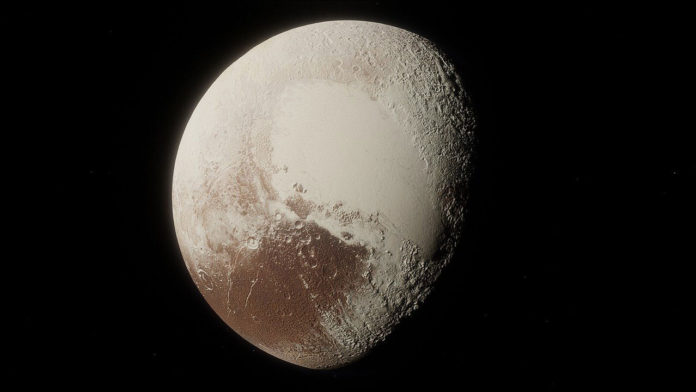It takes 248 Earth years for Pluto to complete one orbit around the Sun. Its orbital path doesn’t lie in the same plane as the eight planets but is inclined at an angle of 17°. Pluto’s unusual orbit is also more oval-shaped or elliptical than those of the planets.
Now considered a dwarf planet, Pluto has been a topic of interest for many scientists due to its eccentric and mysterious nature. Several studies have explained its orbit. A new study suggests that Pluto’s orbit is relatively stable over longer timescales but is subject to chaotic perturbance and changes over shorter timescales.
The study was conducted by Dr. Renu Malhotra, the Louise Foucar Marshall Science Research Professor at the University of Arizona‘s Lunar and Planetary Laboratory (LPL); and Takashi Ito, an associate professor at the Chiba Institute of Technology’s Planetary Exploration Research Center (PERC) and the National Astronomical Observatory of Japan’s (NAOJ) Center for Computational Astrophysics.
Scientists demonstrated that the orbital architecture of the giant planets lies within a narrow niche in which Pluto-like orbits are practically stable on gigayear timescales, whereas nearby are strongly chaotic orbits.
Numerous simulations of Pluto’s past and future orbits have found a startling characteristic that prevents Pluto from colliding with Neptune. “This is the orbital resonance condition known as a “mean motion resonance,” told Dr. Malhotra to Universe Today.
“This condition ensures that when Pluto is at the same heliocentric distance as Neptune, its longitude is nearly 90 degrees away from Neptune‘s. Later another peculiar property of Pluto’s orbit was discovered: Pluto comes to perihelion at a location well above the plane of Neptune’s orbit; this is a different type of orbital resonance known as the ‘vZLK oscillation.’ This abbreviation refers to von Zeipel, Lidov, and Kozai, who studied this phenomenon as part of the ‘three-body problem.'”
Scientists used numerical simulations of Pluto’s orbit for up to five billion years into the Solar System‘s future for their research. Especially, they hoped to address unresolved questions about the peculiar orbits of Pluto and other Pluto-sized objects. In particular, they hoped to address unresolved questions about the peculiar orbits of Pluto and other Pluto-sized objects.
Previous studies which tried to address these questions with new theories got limited success. In this hypothesis, Pluto was pulled into its current mean motion resonance by Neptune, which migrated during the Solar System’s early history.
This theory predicts that other Trans-Neptunian Objects (TNOs) will have the same resonance condition as Plutinos, which has been confirmed by discovering large numbers of Plutinos. As a result of this revelation, the planet migration idea is now more widely accepted.
Dr. Malhotra explained, “Pluto’s orbital inclination is closely linked to its vZLK oscillation. So we reasoned that if we could understand better the conditions for Pluto’s vZLK oscillation, perhaps we could solve the mystery of its inclination. We started by investigating the individual role of the other giant planets (Jupiter, Saturn, and Uranus) on Pluto’s orbit.”
Dr. Malhotra and Ito did this by running computer simulations of Pluto’s orbital history for up to 5 billion years. It includes eight potential combinations of giant planet perturbation. The interactions in these N-body simulations included:
- Neptune (—NP)
- Uranus and Neptune (–UNP)
- Saturn and Neptune (-S-NP)
- Jupiter and Neptune (J–NP)
- Saturn, Uranus, and Neptune (-SUNP)
- Jupiter, Uranus, and Neptune (J-UNP)
- Jupiter, Saturn, and Neptune (JS-NP)
- Jupiter, Saturn, Uranus, and Neptune (JSUNP)
Dr. Malhotra told Universe Today, “We found no subsets of the inner three giant planets would do to recover Pluto’s vZLK oscillation; all three – Jupiter, Saturn, and Uranus – were necessary. But what is it about these planets that [are] essential to Pluto’s vZLK oscillation? There are 21 parameters needed to represent the gravitational forces of Jupiter, Saturn, and Uranus on Pluto. This is a prohibitively large parameter space to explore.”
Scientists simplified these calculations by introducing some simplifications. They represented each planet with a circular ring of uniform density, a total mass equal to the planet’s, and a ring radius equal to the planet’s average distance from the Sun.
This yielded a single parameter representing the effect of Jupiter, Saturn, and Uranus (J2), which was equivalent to the effect of an oblate Sun.
Dr. Malhotra said, “We discovered a fortuitous arrangement of the masses and orbits of the giant planets that delineates a narrow range in the J2 parameter in which Pluto’s vZLK oscillation is possible, a kind of ‘Goldilock’s zone. This result indicates that, during the planet migration era in [the] Solar System’s history, the conditions for Trans-Neptunian objects changed in such a way as to promote many of them – including Pluto – into the vZLK oscillation state. It is likely that Pluto’s inclination originated during this dynamical evolution.”
“I think that our work raises new hope for connecting present-day solar system dynamics and historical solar system dynamics. The origin of the orbital inclinations of minor planets throughout the solar system – including the TNOs – presents a major unsolved problem; perhaps our work will stimulate more attention to it.”
The study could have significant implications for future studies of the outer Solar System and its orbital dynamics. Further study could help astronomers learn more about the migration history of the giant planets and how they eventually settled into their current orbits. It could also lead to discovering a novel dynamical mechanism that will explain the origins of Pluto’s orbit and other bodies with high orbital inclinations.
Journal Reference:
- Renu Malhotra and Takashi Ito. Pluto near the edge of chaos. DOI: 10.1073/pnas.2118692119
